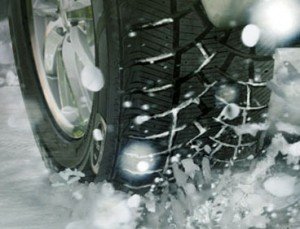 This time of year,
we receive a lot of questions about the advantages of winter tires.
Do they really make a difference? Are they safer? Are winter tires
only necessary on the drive axle? Here is some valuable information
to help you understand winter tires.
This time of year,
we receive a lot of questions about the advantages of winter tires.
Do they really make a difference? Are they safer? Are winter tires
only necessary on the drive axle? Here is some valuable information
to help you understand winter tires.
What are the advantages of winter tires over all-season tires?
The primary advantage of winter tires is improved traction and control in cold weather. Winter tires are made from softer rubber compounds that retain their flexibility in cold weather, allowing the tire to better conform to the surface of the road. In fact, in temperatures of 45 degrees or less, winter tires will increase vehicle stability regardless of road conditions. All-season and performance tires tend to get hard and brittle in cold temperatures – providing less traction. As a result, winter tires keep a better grip on snowy and icy surfaces than regular tires. A Motortrend.com report concludes that “modern winter tires can provide up to 20 percent better snow traction than an all-season design.”
Can I just install two winter tires on the drive axle?
It is not recommended. It’s always best to replace all four tires with winter tires because differences in tire size, traction and wear can negatively affect a car’s handling. As we discussed in a recent article, most 4WD and AWD vehicles recommend replacing all four tires at the same time. Using mismatched tires (tires of different size, circumference, type, manufacturer or tread depth), may force the differentials to operate at all times and cause early failure.
Only installing winter tires on the front wheels increases the risk of losing rear tire traction while braking or cornering on wintery roads (possibility of rear-wheel skids). If you were to just mount winter tires on the rear wheels, your front tires wouldn’t be able to grip the road as well. Any effort to steer the vehicle in the direction you want to go on wintery roads will be more difficult. The Tire Industry Association states “in order to maintain performance and stability, winter/snow tires must be installed on all four wheel positions on front-wheel drive vehicles.”
I have a 4WD or AWD vehicle – will all-season tires be fine for the winter?
A common misunderstanding regarding winter driving is the belief that four-wheel drive (4WD) or all-wheel drive (AWD) vehicles don’t need winter tires because they perform better in winter conditions than two-wheel-drive vehicles. Although 4WD trucks, SUVs, and crossovers may provide more power and increased grip upon acceleration than a two-wheel vehicle, winter driving is all about traction. Stopping, starting, cornering and steering are all controlled by the tires. While 4WD or AWD may help during acceleration, it does not help the vehicle stop. Forbesauto.com writes “a 2WD drive vehicle with snow tires on all four wheels will outperform a 4WD vehicle with regular tires.”
Can I use my vehicle’s traction control feature instead of winter tires?
Ironically, traction control doesn’t actually control traction. It simply limits acceleration so your tires aren’t as likely to spin in wet or wintry conditions. For optimal traction control, you need tires made specifically for your weather conditions. In other words: winter conditions = winter tires.
We’ve shared several videos illustrating the effectiveness of winter tires compared to all-season tires.
If you have any questions regarding winter tires, please feel free to contact us. If you have your winter tires stored with us, please call ahead to schedule a time to have them installed. Don’t wait until the first snowfall, we encourage you to do this soon and avoid long wait times.
